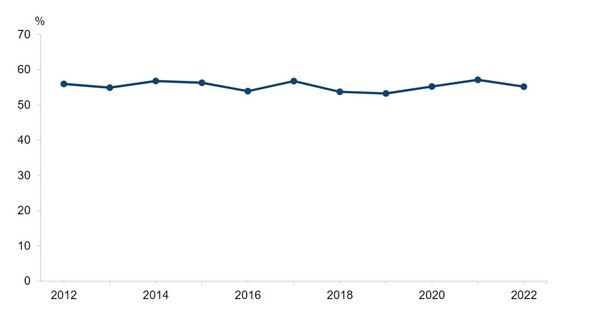The value of home-produced vegetables increased by 4.8% to just under £1.8 billion in 2022, and the volume of home production decreased by 5.8% to 2.4 million tonnes. There was an increase of 7.5% in the value of field vegetables, at £1.4 billion (£98 million increase), while the value of protected vegetables decreased by 4.4% to £371 million (£17 million decrease).
Home-produced fruit has risen in value to just over £1 billion, an increase of 9.5% compared to 2021, with production volumes (increasing 13% to 652 thousand tonnes).
UK ornamentals were worth £1.5 billion in 2022, a decrease of 1.5% compared to 2021.

Areas for vegetables were reduced by 5% at 107 thousand hectares. January was particularly dry, with optimal conditions for carrot, parsnip, and onion drilling and planting. February was increasingly unsettled, with storms hitting some parts of the country, causing damage. The spring and summer were generally warmer than average, and many areas experienced drought, especially in the South and East, with a new UK record temperature of 40.3°C recorded in July. The hot, dry summer presented challenges for growers, needing to irrigate crops far more than usual. The increasing costs of all inputs, such as energy, diesel, fertilizer, and plant protection products, have squeezed grower profitability significantly.
The value of protected vegetables decreased by 4.4% in 2022 to £371 million. Production of protected vegetables fell by 5.7% in 2022 to 247 thousand tonnes, with the area used decreasing by 11%, at 709 hectares. This is the seventh year in a row where protected vegetable production has fallen since peak production in 2015 at 310 thousand tonnes.
Ornamentals
Ornamental plants and flowers were worth £1.5 billion in 2022, a decrease of 1.5% compared to 2021.
Hardy ornamental stock decreased in value by 1.8% to £1.1 billion. 2022 was a challenging year for the hardy nursery stock (HNS) sector due largely to the prolonged severe drought and heatwave. The increased cost of living impacted discretionary spending and so demand, particularly in the retail garden sector.
The pot plant sector decreased by 12% to £285 million. The protected ornamentals sector saw adjustments where some growers reduced production because of the rise in the cost of living and the increasing cost of materials (pots, growing media, etc.), which would increase retail prices.
Flowers and bulbs showed a 29% increase in value to £165 million. Water shortages with the reducing consumer demand because of the drought conditions and increased cost of living further exacerbated matters, particularly in the latter part of the year.
